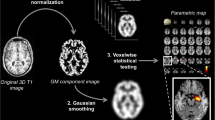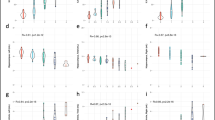Abstract
A quantitative analysis of brain volume can assist in the diagnosis of Alzheimer’s disease (AD) which is ususally accompanied by brain atrophy. With an automated analysis program Quick Brain Volumetry (QBraVo) developed for volumetric measurements, we measured regional volumes and ratios to evaluate their performance in discriminating AD dementia (ADD) and mild cognitive impairment (MCI) patients from normal controls (NC). Validation of QBraVo was based on intra-rater and inter-rater reliability with a manual measurement. The regional volumes and ratios to total intracranial volume (TIV) and to total brain volume (TBV) or total cerebrospinal fluid volume (TCV) were compared among subjects. The regional volume to total cerebellar volume ratio named Standardized Atrophy Volume Ratio (SAVR) was calculated to compare brain atrophy. Diagnostic performances to distinguish among NC, MCI, and ADD were compared between MMSE, SAVR, and the predictive model. In total, 56 NCs, 44 MCI, and 45 ADD patients were enrolled. The average run time of QBraVo was 5 min 36 seconds. Intra-rater reliability was 0.999. Inter-rater reliability was high for TBV, TCV, and TIV (R = 0.97, 0.89 and 0.93, respectively). The medial temporal SAVR showed the highest performance for discriminating ADD from NC (AUC = 0.808, diagnostic accuracy = 80.2%). The predictive model using both MMSE and medial temporal SAVR improved the diagnostic performance for MCI in NC (AUC = 0.844, diagnostic accuracy = 79%). Our results demonstrated QBraVo is a fast and accurate method to measure brain volume. The regional volume calculated as SAVR could help to diagnose ADD and MCI and increase diagnostic accuracy for MCI.


Similar content being viewed by others
Availability of data and material
The data used for the analyses is available on request.
Code availability
The software that we made for the brain volume analysis is available on request from the corresponding author.
References
Braak, H., & Braak, E. (1991). Neuropathological stageing of Alzheimer-related changes. Acta Neuropathologica, 82, 239–259.
Christensen, K. J., Multhaup, K. S., Nordstrom, S., & Voss, K. (1990). Cognitive test profile analysis for the identification of dementia of the Alzheimer type. Alzheimer Disease and Associated Disorders, 4, 96–109.
Coutu, J. P., Goldblatt, A., Rosas, H. D., & Salat, D. H. (2016). White matter changes are associated with ventricular expansion in aging, mild cognitive impairment, and Alzheimer’s disease. Journal of Alzheimer’s Disease, 49, 329–342.
Guenette, J. P., Stern, R. A., Tripodis, Y., Chua, A. S., Schultz, V., Sydnor, V. J., et al. (2018). Automated versus manual segmentation of brain region volumes in former football players. Neuroimage. Clinical, 18, 888–896.
Haller, S., Falkovskiy, P., Meuli, R., Thiran, J. P., Krueger, G., Lovblad, K. O., et al. (2016). Basic MR sequence parameters systematically bias automated brain volume estimation. Neuroradiology, 58, 1153–1160.
Heinen, R., Bouvy, W. H., Mendrik, A. M., Viergever, M. A., Biessels, G. J., & de Bresser, J. (2016). Robustness of automated methods for brain volume measurements across different MRI field strengths. PLoS ONE, 11, e0165719.
Jacobs, H. I. L., Hopkins, D. A., Mayrhofer, H. C., Bruner, E., van Leeuwen, F. W., Raaijmakers, W., et al. (2018). The cerebellum in Alzheimer’s disease: Evaluating its role in cognitive decline. Brain, 141, 37–47.
Kiraly, A., Szabo, N., Toth, E., Csete, G., Farago, P., Kocsis, K., et al. (2016). Male brain ages faster: The age and gender dependence of subcortical volumes. Brain Imaging and Behavior, 10, 901–910.
Lane, C. A., Hardy, J., & Schott, J. M. (2018). Alzheimer’s disease. European Journal of Neurology, 25(1), 59–70. https://doi.org/10.1111/ene.13439
Lombardi, G., Crescioli, G., Cavedo, E., Lucenteforte, E., Casazza, G., Bellatorre, A. G., … Filippini, G. (2020). Structural magnetic resonance imaging for the early diagnosis of dementia due to Alzheimer's disease in people with mild cognitive impairment. Cochrane Database Syst Rev, 3(3), Cd009628. https://doi.org/10.1002/14651858.CD009628.pub2
Mangialasche, F., Solomon, A., Winblad, B., Mecocci, P., & Kivipelto, M. (2010). Alzheimer’s disease: Clinical trials and drug development. The Lancet. Neurology, 9, 702–716.
Möller, C., Vrenken, H., Jiskoot, L., Versteeg, A., Barkhof, F., Scheltens, P., et al. (2013). Different patterns of gray matter atrophy in early- and late-onset Alzheimer’s disease. Neurobiology of Aging, 34, 2014–2022.
Moon, C. M., Shin, I. S., & Jeong, G. W. (2017). Alterations in white matter volume and its correlation with neuropsychological scales in patients with Alzheimer’s disease: A DARTEL-based voxel-based morphometry study. Acta Radiologica, 58(2), 204–210. https://doi.org/10.1177/0284185116640162
Murray, M. E., Graff-Radford, N. R., Ross, O. A., Petersen, R. C., Duara, R., & Dickson, D. W. (2011). Neuropathologically defined subtypes of Alzheimer’s disease with distinct clinical characteristics: A retrospective study. The Lancet. Neurology, 10, 785–796.
Nordenskjöld, R., Malmberg, F., Larsson, E. M., Simmons, A., Brooks, S. J., Lind, L., et al. (2013). Intracranial volume estimated with commonly used methods could introduce bias in studies including brain volume measurements. NeuroImage, 83, 355–360.
Parker, T. D., Slattery, C. F., Yong, K. X. X., Nicholas, J. M., Paterson, R. W., Foulkes, A. J. M., … Schott, J. M. (2019). Differences in hippocampal subfield volume are seen in phenotypic variants of early onset Alzheimer's disease. Neuroimage Clinical, 21, 101632. https://doi.org/10.1016/j.nicl.2018.101632
Petersen, R. C. (2004). Mild cognitive impairment as a diagnostic entity. Journal of Internal Medicine, 256, 183–194.
Poulakis, K., Pereira, J. B., Mecocci, P., Vellas, B., Tsolaki, M., Kloszewska, I., et al. (2018). Heterogeneous patterns of brain atrophy in Alzheimer’s disease. Neurobiology of Aging, 65, 98–108.
Qing, Z., & Gong, G. (2016). Size matters to function: Brain volume correlates with intrinsic brain activity across healthy individuals. NeuroImage, 139, 271–278.
Ramos Bernardes da Silva Filho, S., Oliveira Barbosa, J. H., Rondinoni, C., Dos Santos, A. C., Garrido Salmon, C. E., da Costa Lima, N. K., … Moriguti, J. C. (2017). Neuro-degeneration profile of Alzheimer's patients: A brain morphometry study. Neuroimage Clinical, 15, 15–24. https://doi.org/10.1016/j.nicl.2017.04.001
Reiter, K., Nielson, K. A., Durgerian, S., Woodard, J. L., Smith, J. C., Seidenberg, M., et al. (2017). Five-year longitudinal brain volume change in healthy elders at genetic risk for Alzheimer’s disease. Journal of Alzheimer’s Disease, 55, 1363–1377.
Risacher, S. L., Anderson, W. H., Charil, A., Castelluccio, P. F., Shcherbinin, S., Saykin, A. J., et al. (2017). Alzheimer disease brain atrophy subtypes are associated with cognition and rate of decline. Neurology, 89, 2176–2186.
Saribudak, A., Subick, A. A., Kim, N. H., Rutta, J. A., & Uyar, M. U. (2020). Gene expressions, hippocampal volume loss, and MMSE scores in computation of progression and pharmacologic therapy effects for Alzheimer’s disease. IEEE/ACM Transactions on Computational Biology and Bioinformatics, 17(2), 608–622. https://doi.org/10.1109/tcbb.2018.2870363
Tabatabaei-Jafari, H., Shaw, M. E., Walsh, E., & Cherbuin, N. (2019). Regional brain atrophy predicts time to conversion to Alzheimer’s disease, dependent on baseline volume. Neurobiology of Aging, 83, 86–94. https://doi.org/10.1016/j.neurobiolaging.2019.08.033
Tan, C. C., Yu, J. T., & Tan, L. (2014). Biomarkers for preclinical Alzheimer’s disease. Journal of Alzheimer’s Disease, 42, 1051–1069.
Ten Kate, M., Dicks, E., Visser, P. J., van der Flier, W. M., Teunissen, C. E., Barkhof, F., et al. (2018). Atrophy subtypes in prodromal Alzheimer’s disease are associated with cognitive decline. Brain, 141, 3443–3456.
Toniolo, S., Serra, L., Olivito, G., Marra, C., Bozzali, M., & Cercignani, M. (2018). Patterns of cerebellar gray matter atrophy across Alzheimer’s disease progression. Frontiers in Cellular Neuroscience, 12, 430. https://doi.org/10.3389/fncel.2018.00430
van Loenhoud, A. C., Groot, C., Vogel, J. W., van der Flier, W. M., & Ossenkoppele, R. (2018). Is intracranial volume a suitable proxy for brain reserve? Alzheimer’s Research & Therapy, 10, 91.
Vernooij, M. W., Jasperse, B., Steketee, R., Koek, M., Vrooman, H., Ikram, M. A., et al. (2018). Automatic normative quantification of brain tissue volume to support the diagnosis of dementia: A clinical evaluation of diagnostic accuracy. Neuroimage. Clinical, 20, 374–379.
Vibha, D., Tiemeier, H., Mirza, S. S., Adams, H. H. H., Niessen, W. J., Hofman, A., et al. (2018). Brain volumes and longitudinal cognitive change: A population-based study. Alzheimer Disease and Associated Disorders, 32, 43–49.
Vogel, J. W., Vachon-Presseau, E., Pichet Binette, A., Tam, A., Orban, P., La Joie, R., … Villeneuve, S. (2018). Brain properties predict proximity to symptom onset in sporadic Alzheimer's disease. Brain, 141(6), 1871–1883. https://doi.org/10.1093/brain/awy093
Zhang, Y., & Liu, S. (2018). Analysis of structural brain MRI and multi-parameter classification for Alzheimer’s disease. Biomedizinische Technik (Berl), 63(4), 427–437. https://doi.org/10.1515/bmt-2016-0239
Funding
This study was supported by a grant from the Ministry of Health and Welfare (HI18C0530) and by the Health Fellowship Foundation.
Author information
Authors and Affiliations
Contributions
DW Ryu: Conceptualization; Methodology; Validation; Formal analysis; Data curation, Writing—original draft preparation, review and editing; Approval of final manuscript, YJ Hong: Formal analysis; Data curation; Approval of final manuscript, JH Cho: Software; Formal analysis; Approval of final manuscript, KC Kwak: Software; Validation; Approval of final manuscript, JM Lee: Software; Approval of final manuscript, YS Shim: Formal analysis; Data curation; Approval of final manuscript, YC Youn: Formal analysis; Data curation; Approval of final manuscript, DW Yang: Conceptualization; Methodology; Software; Validation; Data curation; Writing—original draft preparation, review and editing; Approval of final manuscript.
Corresponding author
Ethics declarations
Ethics approval
The study protocol was approved by the institutional review board and the ethical standard committee at our institution.
Consent to participate
The ethics board determined that participant consent was not required for the retrospective observations.
Consent for publication
All the authors aggressed with the publication of this article.
Conflicts of interest
Authors had confirmed that there is no conflict of interest to disclose.
Additional information
Publisher's note
Springer Nature remains neutral with regard to jurisdictional claims in published maps and institutional affiliations.
Rights and permissions
About this article
Cite this article
Ryu, DW., Hong, Y.J., Cho, J.H. et al. Automated brain volumetric program measuring regional brain atrophy in diagnosis of mild cognitive impairment and Alzheimer’s disease dementia. Brain Imaging and Behavior 16, 2086–2096 (2022). https://doi.org/10.1007/s11682-022-00678-x
Accepted:
Published:
Issue Date:
DOI: https://doi.org/10.1007/s11682-022-00678-x




